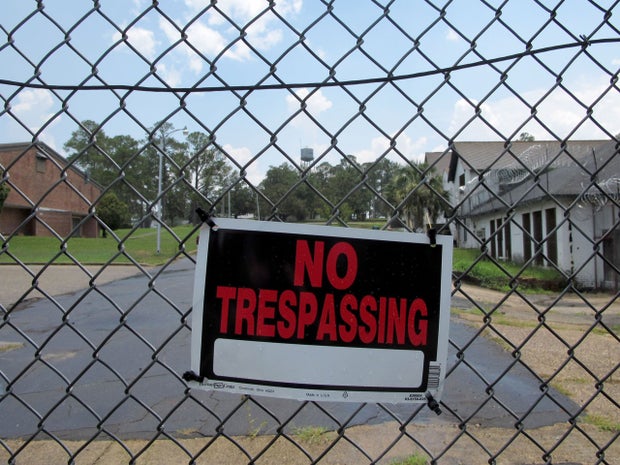Researchers uncover more deaths at shuttered Fla. school
They call themselves the "White House Boys": Survivors of a brutal upbringing at a rural northern Florida reform school, named for the building in which they were repeatedly whipped with a leather strap.
Decades later, the friends and families of boys weren't lucky enough to survive are one step closer to finding the truth about their missing relatives.
An anthropological investigation into abuse and death at the now-shuttered Arthur G. Dozier School for Boys found a record of 98 students died between 1914 and 1973 -- 19 more than what a state probe previously uncovered. They also have strong evidence that a second burial site -- for white students, since the school was segregated by race -- has yet to be discovered.
Using ground-penetrating radar, studying historical records and a number of other methods, researchers at the University of Southern Florida announced Monday that most of the boys who died had passed away within their first few weeks at the state-sponsored school for troubled youth in Marianna, Fla. The youngest victims were two 6-year-old boys. The Florida Department of Justice announced last year it had found 81 individuals had died.
"In some ways, it's a complicated and long history," Dr. Erin Kimmerle, the anthropologist leading the investigation, told CBS "Evening News" correspondent Manuel Bojorquez. "But part of it's really simple and that is that these children went into state custody and many of them didn't come back."
Of the total 98 deaths uncovered by the USF researchers, 45 individuals were buried on school grounds, 31 were shipped to other locations for burial and 22 bodies are still unaccounted for.
Even among those with graves marked with white crosses, little information is known about their deaths. Records cite infectious disease, fires, physical trauma and drowning. But survivors' personal accounts give a very different story of physical, emotional and in many cases sexual abuse in the hands of their caretakers. The end goal is to dig up those graves and exhume the bodies.
The Dozier School, also known as Florida State Reform School, opened in 1900 to take in children who committed crimes. Stories of abuse began surfacing as early as 1980, but the "White House Boys" didn't come together as a community until the 2000s. Robert Staley, a former Dozier student featured on one of at least two books about the school's past, played a major role in connecting and reaching out to other victims online.
"What hurt the most was the fact that you were so young and had that level of brutality inflected on you at such an early age, that you were traumatized for life," Straley said on CBS "Evening News."
Another former student, William A. Haynes, wrote he was beaten at the so-called White House eight times. The first time was so bad, pieces of his underwear were imbedded in his skin.
"There was no way to be prepared for what was done to me. I could hear the sound of a shoe turning on the concrete floor as the swing was made with a leather strap. Immediately following that sound, I felt the worst pain I had experienced in my life," Haynes wrote. "Mr. Hatton gave me 45 licks with the strap and then told me to 'get my ass up and let's go.'"
That testimony was an affidavit in a class-action lawsuit by the White House Boys in 2010 that involved 300 former students. Both the Florida Department of Justice and the U.S. Department of Justice held investigations into the allegations of killing and abuse, and the school shuttered in 2011. But neither case led to criminal charges and dozens of families still did not know where their loved ones were buried. The White House Boys continued to demand more justice.
The Varnadoe family, with the team lead by Dr. Kimmerle, is spearheading the current investigation to uncover those stories and if possible, bring the remains of lost relatives home. Records state that Glen Varnadoe's uncle, Thomas, died at the school on his 34th day there when he was 13 due to "pneumonia." Glen and his family, like many other White House Boy families, don't believe that story and want to uncover his body.
The Varnadoes say that Thomas was a healthy child when he arrived at the school with his brother, Hubert. They were both charged with "malicious trespassing."
"Hubert, who was still incarcerated at the time, later told his mother that a minister, a grave digger, and himself were the only people at the funeral. He further told his brother Richard that Thomas was buried near a large tree on the school grounds," the report states. But despite repeatedly contacting administrators, the Varnadoes said no one can pinpoint exactly where his body lies.
When the State of Florida planned on selling the property, the Varnadoes intervened. In October, a judge ruled that the state must hold off on selling the property until Thomas' body is found.
The USF report, however, is just a checkpoint in an ongoing investigation. Bob Bolt, the attorney for the Varnadoe family, told CBS News they strongly believe there is a second burial site on school grounds that that they must uncover before they can start digging things up.
"It's a segregated facility -- they don't mix white and black burials," Bolt said, explaining that the only burial site found so far was for the black students. Thomas was white. "We're looking for [Thomas]. We don't know what the timeline will be until we find the body."
Bolt also said he and the Varnadoes plan on asking the state for more assistance. The investigation is getting more costly and he said they need to be taking a bigger role.
"We're going to be asking the state to take over responsibilities," Bolt said.
Meanwhile, the search for Thomas is just one part of a decades-old mystery that involves dozens of lost boys.


